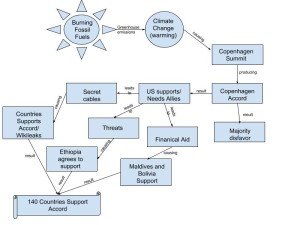
- For my diagram I tried to show the flow of how things occurred in order for support to be gained for the Copenhagen Accord. I began at the beginning, the problem, fossil fuels. As we all know burning of fossil fuels create greenhouse gases that result in climate change. That was the first thing I decided to list in my diagram. I put the fossil fuels in a sun to symbolize burning, there was no flame shape other than that. I put the climate change in a circle to symbolize the globe. Next I went on to mention the result of climate change, the Copenhagen Summit in which the Copenhagen Accord was created. A lot of countries initially weren’t in favor of the Accord, however the US was. It would greatly benefit the US if the Accord was accepted so the worked to gain allies and supporters. The US did this in several ways; cables, threats, and financial aid. Countries that were most severely affected by climate change not caused by themselves were promised money if they supported the Accord. Maldives is a small island country that was in need of money so they agreed. Bolivia also agreed, though they did not want to support the Accord, they needed money. Threats came, like that to Ethiopia, that communications with them would end if they did not support the Accord and the threats worked. Ethiopia agreed to support it. Finally cable were sent out that resulted in Wikileaks tapping the cables and leaking information on the aid, threats, and cable spying US was doing in order to gain support for their cause. In the end the efforts of the US and our allies allowed for support of the accord from 140 out of 193 countries involved in the climate change initiative. I illustrated that by having my flow chart end with the results of the US efforts.
- I don’t like how the US conducted some of its negotiations. By spying and threatening countries I believe they crossed some ethical boundaries. I don’t think it’s right the spy on people or make threats because you aren’t getting your way. However at the same time, thinking about action ethics and if the end justifies the means, what the US did may be ok. There needs to be a plan in place to attack climate change, one where everyone on board is doing their part and working towards a better future. The US was able to make a large jump in that direction by getting so many countries to jump on board. Maybe there was a better way to accomplish this than the methods the US implemented, but in the end 140 of 193 countries are not following the accord, so maybe the means of getting to the end are justified, I don’t know who is entitled to be the judge of that. We will have to see how it works. The bullying and secretive ways of the US in this instance may, short-term, result in a group effort, but long-term we may see countries backing out, doing the bare minimum to say they are following the according, or just pretending to do so. I think I is up to the individual person and country to decide to do something, in order for any progress to actually be achieve.
2 thoughts on “Module 9: Climate Change- Samantha Luchansky”
Leave a Reply
You must be logged in to post a comment.

Hi Samantha! My name is Shanda. Here’s a link to my blog for this week https://wp.me/p3RCAy-dQ1
I started my diagram pretty much the same way you did, only instead of starting with burning fossil fuels, I started with the industrial revolution. I understand what you’re saying about the distributive justice vs the procedural justice approach. At the end of the day, I can’t really see how the end justifies the means, but as of right now I think that the only good thing about the treaty is that it increases the economy for right now.!
It’s hard for me to justify it as well, but I like looking on the positive side of things and hopefully it will do more than just improve the economy